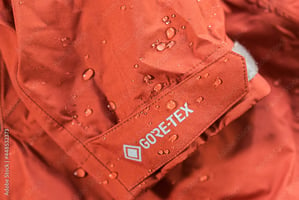Routine maintenance & care is essential to the longevity of GORE-TEX rainwear. This article details...
Daily Care (Washing Method) for Gore-Tex
In the previous article, we explained that Gore-Tex has high performance, but that this performance cannot be utilized without maintenance, and we also proposed a method of thinking about maintenance as being divided into daily maintenance and irregular maintenance.
In this article, we will explain in detail how to wash Gore-Tex as part of daily maintenance for Gore-Tex.
The misconception that it is better not to wash Gore-Tex
When I spoke to a company that rents out outdoor equipment, they said that they don't wash their products. When I asked why, the person said it was because it could maintain its water-repellent properties. They also said that even after three years, it was still maintaining its water-repellent properties.
There are two misconceptions here.
Firstly, that washing will reduce the water-repellent properties of Gore-Tex, and secondly, that maintaining the water-repellent properties of Gore-Tex is the same as maintaining its performance.
The point that the water-repellent performance of Gore-Tex deteriorates with washing
This is not 100% true. It is true that washing does cause some reduction in water-repellent performance. However, if you wash correctly, the reduction in water-repellent performance is not significant, as confirmed by testing. If you wash incorrectly, the reduction in water-repellent performance will be significant. For this reason, we will explain the correct washing method and points to be careful of later on.
Even if you wash your outdoor gear several dozen times, the manufacturer has confirmed that the water-repellent performance will be maintained, and it is sold accordingly. The rate of decline in water repellency due to washing is not that great, and the problem is that it declines due to stress during actual use, especially stress caused by abrasion. If the water repellent coating comes off, even if you wash it or apply heat, the water repellency will not return, so you will need to reapply the water repellent treatment.
Maintaining the water-repellent properties is the key to maintaining the performance of Gore-Tex
Maintaining the water-repellent performance is a necessary condition for Gore-Tex to demonstrate its performance. However, it is not the case that as long as the water-repellent performance is maintained, there will be no problem. As we explained in the previous video about the structure of Gore-Tex, the breathability of Gore-Tex is affected by the condition of the fabric that is layered on top of it, so if the fabric is dirty, the breathability will be impaired even if the Gore-Tex membrane is in good condition. This is particularly true of dirt on the inside, i.e. the side that touches your body, and the build-up of sebum dirt can also lead to a blockage of breathability.
As you can see, a blockage of breathability can also be caused by the build-up of dirt, so it is necessary to wash your jacket regularly to remove sebum dirt from the inside and dirt from the outside.
How to wash a Gore-Tex jacket
You can wash your Gore-Tex jacket in the washing machine just like any other clothes, but there are some points to be careful of. Please wash your jacket while paying attention to the following points.
1) Choosing detergent
The choice of detergent is important. Although it is possible to wash it with ordinary detergent, you need to be careful as some ordinary detergents leave excess ingredients in the fibers to maintain softness. The most important thing when choosing a detergent for Gore-Tex is that it rinses well. It is important to make sure that as little detergent as possible remains after rinsing.
For this reason, use detergents specially made for outdoor use, such as those sold by NIKWAX and Grangers, which are manufacturers of water-repellent agents.
2) Amount of detergent
As many of the detergents specially made for outdoor use are mild and don't remove dirt easily, you may be tempted to use a lot of detergent. However, please be careful not to use too much detergent in order to maintain the rinsing properties.
Soak the inside of the neck and arm areas of the jacket, where dirt tends to accumulate, in detergent beforehand, and then wash the jacket after rubbing in the detergent lightly, to make it easier to remove the dirt.
3) Close the zipper and put it in a net
Putting the jacket in a net or washing it inside out will prevent damage to parts such as the zipper. Also, make sure to close the zippers on the jacket's pockets completely. This will prevent water from collecting in the pockets and putting too much strain on the washing machine or the jacket.
4) Washing course (more rinsing, no spin-drying)
The normal washing cycle is fine. If you can set the machine to rinse twice or three times, do it three times. It is important to rinse out the detergent thoroughly. And don't do the final spin-drying at the end of the wash cycle. The aim here is to prevent excessive stress on the washing machine and the jacket.
5) Drying
After rinsing, take the jacket out of the washing machine. As there is no spin-drying, the jacket will be very wet, so squeeze out the excess water inside the washing machine, and then take it out when the water has all but disappeared.
After that, hang it up to dry in the shade. Hang it up in a well-ventilated place until all the water has dried out.
6) Heat treatment
Once the jacket is completely dry, give it a final heat treatment. Put it in the dryer for about 20 minutes to heat the entire jacket. This will reactivate the coating on the surface of the fabric and restore its water-repellent properties.
These are the steps you should follow for everyday care.
You don't need to wash it after every use, but you should wash it after wearing it for a long time, for example, if you wore it for the whole time you were hiking, or after using it for a certain amount of time. You can think of it in the same way as a normal jacket.
On the other hand, there are cases where the water-repellent performance does not recover even after following the above steps 1 to 5. The water-repellent coating may come off due to friction or wear and tear as you use the jacket. In this case, the water-repellent performance will not recover even if you perform heat treatment. If the water-repellent performance is lost, you will need to have the jacket re-water-repellent treated.
When to re-waterproof Gore-Tex
The timing for re-waterproofing will depend on how you use your rain jacket. As the water-repellent coating does not deteriorate over time if it is not used, the timing for re-waterproofing will differ depending on how each person uses their jacket, but it is a good idea to do it once a season.
Next time, we will explain how to re-waterproof your jacket as irregular maintenance.



.jpg?height=200&name=vol03(1).jpg)